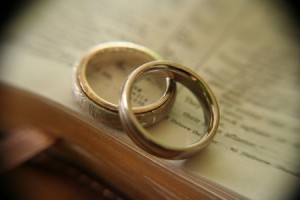Signs the Secular Left is Facing Up to the U.S. Marriage Crisis
 Is it possible that secular liberals, some of them anyway, are starting to realize that knocking the supports out from under traditional marriage may not be such a great idea? If so, and if their next step is to think seriously about how to halt this destructive process, it will be the dawning of a new day.
Is it possible that secular liberals, some of them anyway, are starting to realize that knocking the supports out from under traditional marriage may not be such a great idea? If so, and if their next step is to think seriously about how to halt this destructive process, it will be the dawning of a new day.
The latest indication of such stirrings on the left that I’ve come across is an op-ed piece by Washington Post columnist Ruth Marcus. “If current trends hold,” Marcus writes, “within a few years, less than half the U.S. adult population will be married.” And that, she adds solemnly, is bad news.
Bad news indeed, but not exactly new. The numbers have been piling up for a long time. The U.S. marriage rate (marriages per 1,000 population) was 8.4 in 1958, 10.9 in 1972, and 10.6 in 1981. But by 2009, the rate had fallen to 7.1 and in 2010 it declined still further, to 6.8. The birth rate has followed a similar trajectory, falling from 23.7 in 1960 to 13.5 in 2009.
One obvious reason for what’s happening is that people are marrying later. The median age of first marriage in 1960 was 22.8 for men and 20.3 for women, but by 2003 it had risen to 27.1 and 25.3 respectively.
Another large part of the explanation, however, is that more people aren’t getting married at all. Put the late-marriers and the non-marriers together and then add people who are in-between marriages, and you find that while nearly three-fourths of Americans 18 and older were married in 1960, the figure was a measly 51% in 2010, with the trend still headed down. (Among the college-educated, 27% say marriage is obsolete, while the percentage is 45% among those without college educations.)
Drawing her numbers from a new Pew Rearch Center study that Marcus calls “startling and disturbing,” the Post columnist informs us that the falling marriage rate “isn’t just a social problem. It’s also an economic problem.”
Well, yes. There’s a very visible correlation between marriage and education (nearly two-thirds with college degrees are married but fewer than half of those with high school diplomas or less) and between education and income. (The more education, the higher the income.) As marriages decline, the gap between rich and poor grows wider.
But even though the cluster of problems here has very real economic dimensions, reducing it all to economics while ignoring the links to cultural pathologies and destructive personal values is a mistake. Marcus touches on this other dimension when she speaks of “generational impact”—the impact on children of being raised by cohabiting parents or a single parent. Less education and lower income are part of it—but so are psychological and behavioral difficulties expressed in dropping out of school, law-breaking and incarceration, and other life-destroying behaviors including those that militate against stable marriage.
Unfortunately, Marcus weakens her argument by knee-jerk sneering at conservative “rhapsodizing about the benefits of marriage.” (Maybe good secular liberals don’t rhapsodize.) Remember: “promoting marriage among welfare recipients was a big deal during the George W. Bush administration.” Which makes it wrong? Ideological blinders like that are obstacles to seeking and finding solutions.
Catholics both share in and contribute to the multiple problems of marriage in America. But that subject requires another column, where there may also be an opportunity to suggest a modest solution or two. For now, it’s enough to face up to the fact that we’ve got a marriage crisis on our hands.

